Strategic Supply Chain Management & Logistics: Nestle Middle East
VerifiedAdded on 2023/06/13
|18
|4497
|408
Report
AI Summary
This report examines Nestle Middle East's strategic supply chain management and logistics, highlighting the relationship between the supply chain and organizational business objectives. It assesses the importance of effective supply chain management, its link with other business functions, and key drivers for an integrated strategy. The report further explores the use of information technology to optimize supplier relationships, detailing strategies, IT implementation, and system development for maintaining these relationships. Additionally, it assesses the role of information technology in integrating different parts of the supply chain and its contribution to overall management effectiveness. The document also addresses the role of logistics and procurement, factors for improvement, and proposes a strategy to enhance Nestle's supply chain, including benefits and techniques to overcome implementation barriers. The analysis provides a comprehensive overview of Nestle's supply chain practices and recommendations for future enhancements.
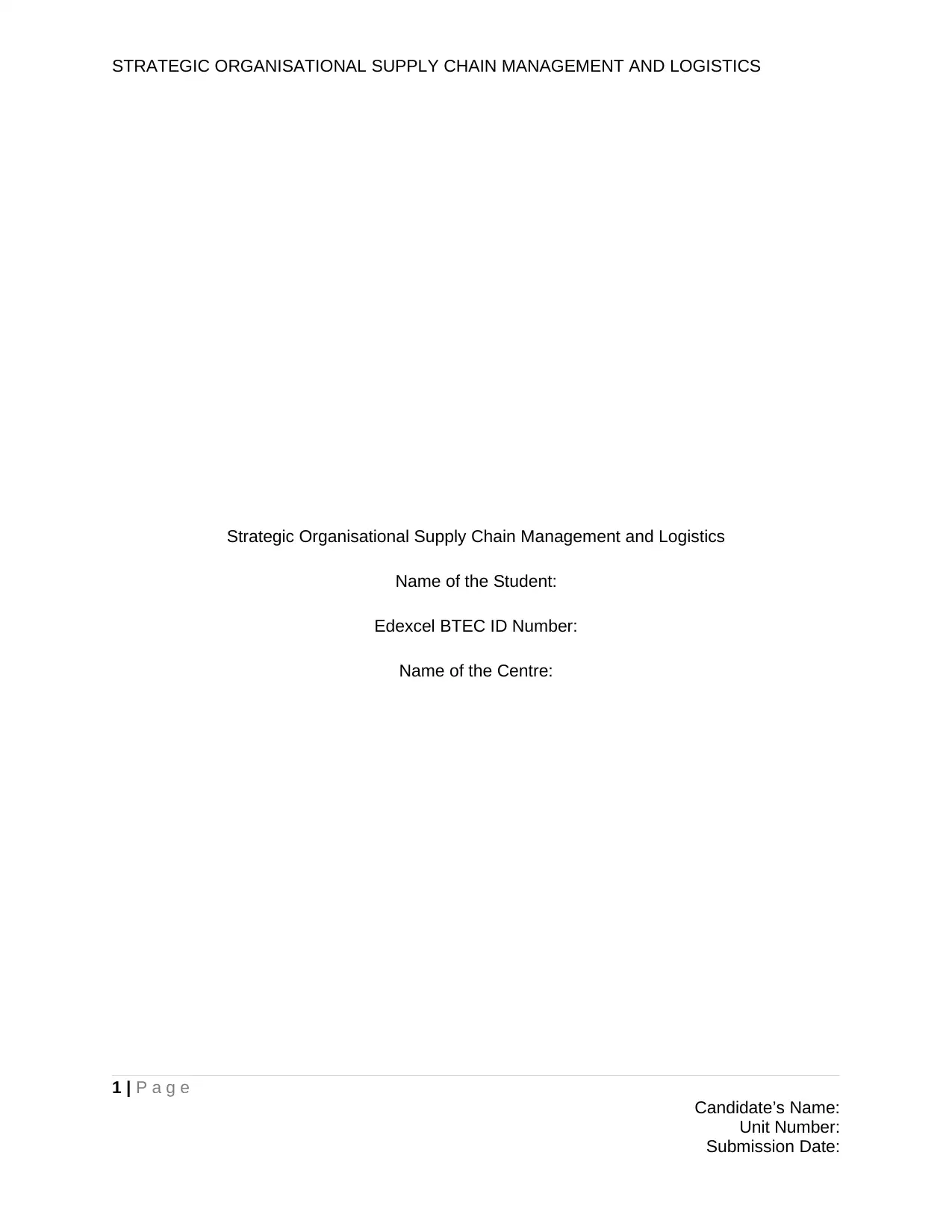
STRATEGIC ORGANISATIONAL SUPPLY CHAIN MANAGEMENT AND LOGISTICS
Strategic Organisational Supply Chain Management and Logistics
Name of the Student:
Edexcel BTEC ID Number:
Name of the Centre:
1 | P a g e
Candidate’s Name:
Unit Number:
Submission Date:
Strategic Organisational Supply Chain Management and Logistics
Name of the Student:
Edexcel BTEC ID Number:
Name of the Centre:
1 | P a g e
Candidate’s Name:
Unit Number:
Submission Date:
Paraphrase This Document
Need a fresh take? Get an instant paraphrase of this document with our AI Paraphraser
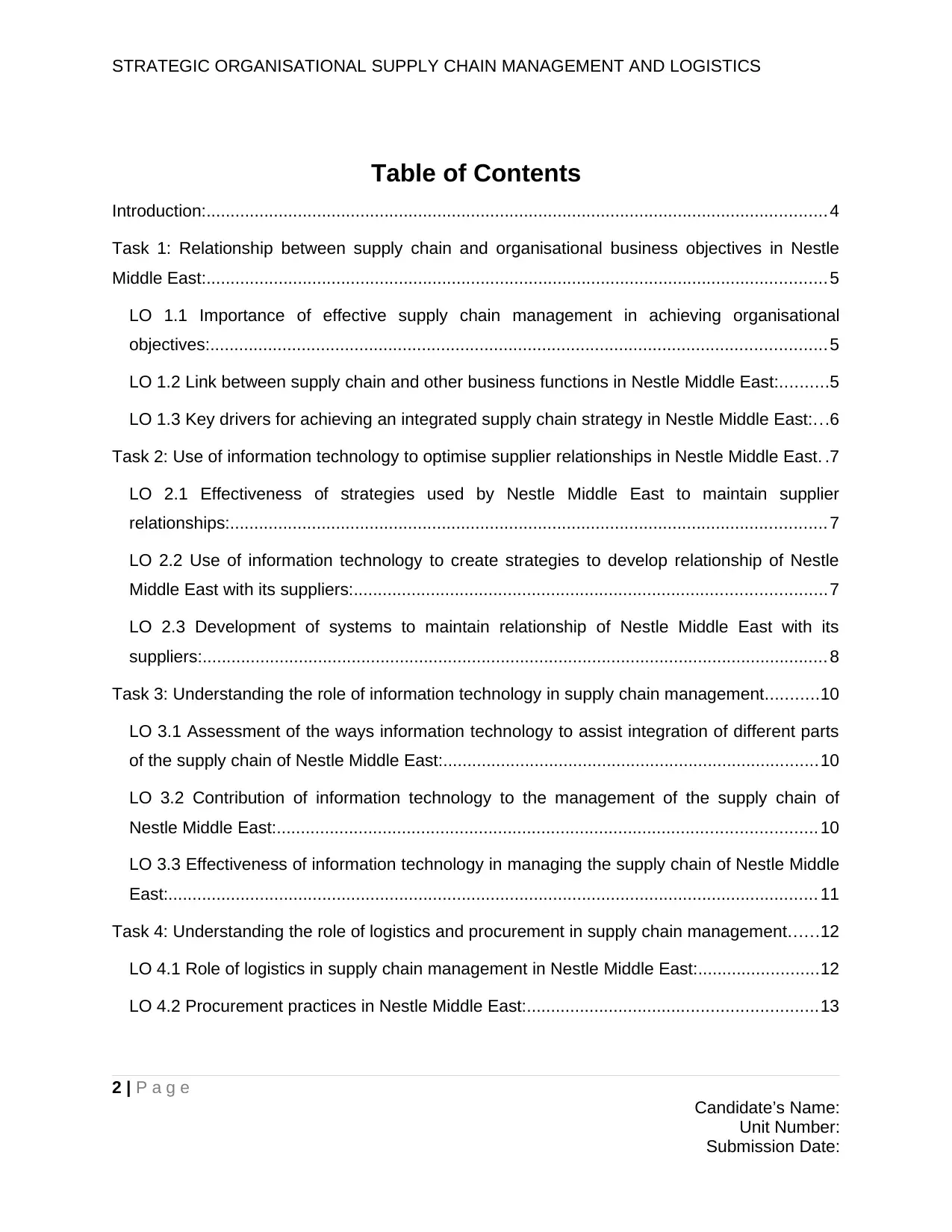
STRATEGIC ORGANISATIONAL SUPPLY CHAIN MANAGEMENT AND LOGISTICS
Table of Contents
Introduction:................................................................................................................................. 4
Task 1: Relationship between supply chain and organisational business objectives in Nestle
Middle East:................................................................................................................................. 5
LO 1.1 Importance of effective supply chain management in achieving organisational
objectives:................................................................................................................................ 5
LO 1.2 Link between supply chain and other business functions in Nestle Middle East:..........5
LO 1.3 Key drivers for achieving an integrated supply chain strategy in Nestle Middle East:...6
Task 2: Use of information technology to optimise supplier relationships in Nestle Middle East. .7
LO 2.1 Effectiveness of strategies used by Nestle Middle East to maintain supplier
relationships:............................................................................................................................ 7
LO 2.2 Use of information technology to create strategies to develop relationship of Nestle
Middle East with its suppliers:..................................................................................................7
LO 2.3 Development of systems to maintain relationship of Nestle Middle East with its
suppliers:.................................................................................................................................. 8
Task 3: Understanding the role of information technology in supply chain management...........10
LO 3.1 Assessment of the ways information technology to assist integration of different parts
of the supply chain of Nestle Middle East:..............................................................................10
LO 3.2 Contribution of information technology to the management of the supply chain of
Nestle Middle East:................................................................................................................ 10
LO 3.3 Effectiveness of information technology in managing the supply chain of Nestle Middle
East:....................................................................................................................................... 11
Task 4: Understanding the role of logistics and procurement in supply chain management......12
LO 4.1 Role of logistics in supply chain management in Nestle Middle East:.........................12
LO 4.2 Procurement practices in Nestle Middle East:............................................................13
2 | P a g e
Candidate’s Name:
Unit Number:
Submission Date:
Table of Contents
Introduction:................................................................................................................................. 4
Task 1: Relationship between supply chain and organisational business objectives in Nestle
Middle East:................................................................................................................................. 5
LO 1.1 Importance of effective supply chain management in achieving organisational
objectives:................................................................................................................................ 5
LO 1.2 Link between supply chain and other business functions in Nestle Middle East:..........5
LO 1.3 Key drivers for achieving an integrated supply chain strategy in Nestle Middle East:...6
Task 2: Use of information technology to optimise supplier relationships in Nestle Middle East. .7
LO 2.1 Effectiveness of strategies used by Nestle Middle East to maintain supplier
relationships:............................................................................................................................ 7
LO 2.2 Use of information technology to create strategies to develop relationship of Nestle
Middle East with its suppliers:..................................................................................................7
LO 2.3 Development of systems to maintain relationship of Nestle Middle East with its
suppliers:.................................................................................................................................. 8
Task 3: Understanding the role of information technology in supply chain management...........10
LO 3.1 Assessment of the ways information technology to assist integration of different parts
of the supply chain of Nestle Middle East:..............................................................................10
LO 3.2 Contribution of information technology to the management of the supply chain of
Nestle Middle East:................................................................................................................ 10
LO 3.3 Effectiveness of information technology in managing the supply chain of Nestle Middle
East:....................................................................................................................................... 11
Task 4: Understanding the role of logistics and procurement in supply chain management......12
LO 4.1 Role of logistics in supply chain management in Nestle Middle East:.........................12
LO 4.2 Procurement practices in Nestle Middle East:............................................................13
2 | P a g e
Candidate’s Name:
Unit Number:
Submission Date:
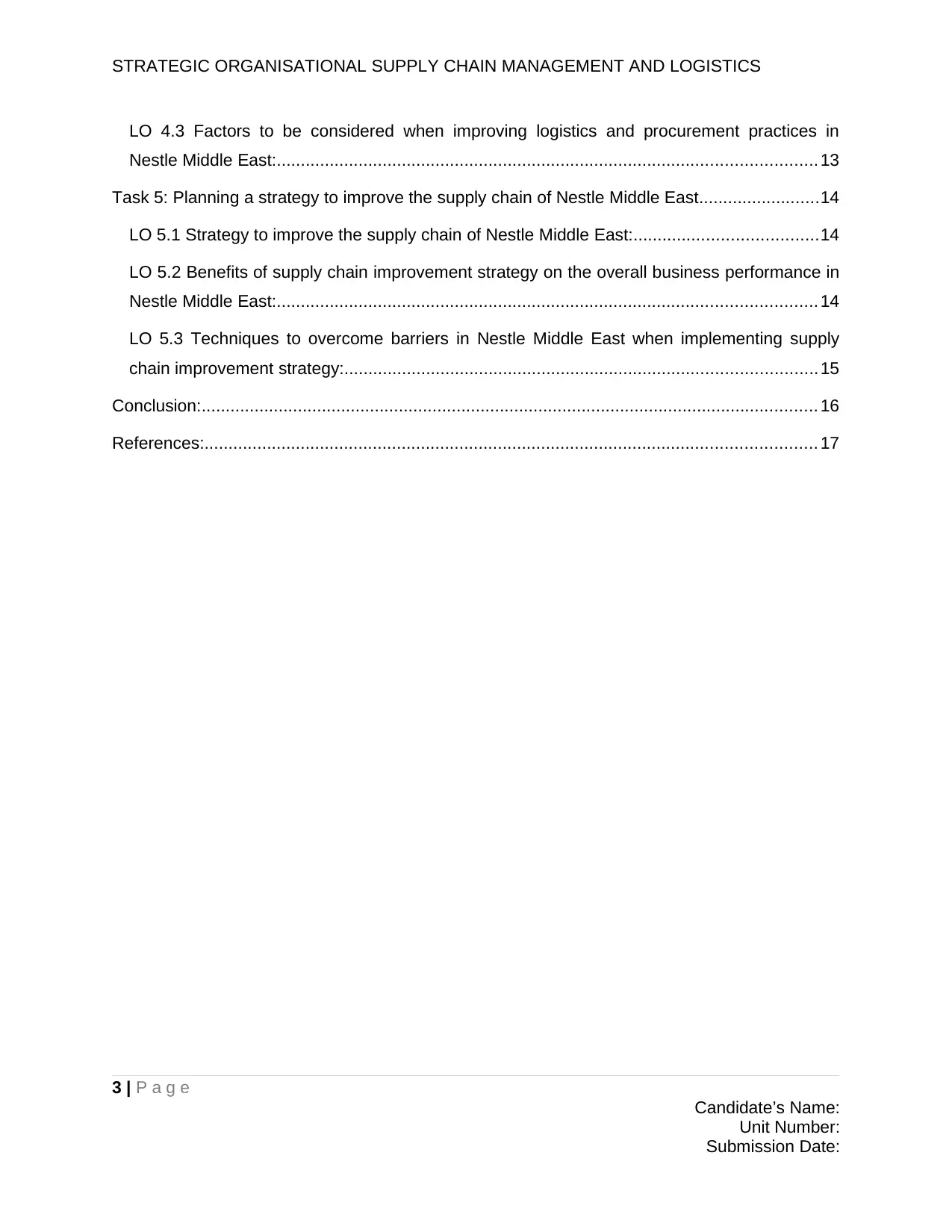
STRATEGIC ORGANISATIONAL SUPPLY CHAIN MANAGEMENT AND LOGISTICS
LO 4.3 Factors to be considered when improving logistics and procurement practices in
Nestle Middle East:................................................................................................................ 13
Task 5: Planning a strategy to improve the supply chain of Nestle Middle East.........................14
LO 5.1 Strategy to improve the supply chain of Nestle Middle East:......................................14
LO 5.2 Benefits of supply chain improvement strategy on the overall business performance in
Nestle Middle East:................................................................................................................ 14
LO 5.3 Techniques to overcome barriers in Nestle Middle East when implementing supply
chain improvement strategy:..................................................................................................15
Conclusion:................................................................................................................................ 16
References:............................................................................................................................... 17
3 | P a g e
Candidate’s Name:
Unit Number:
Submission Date:
LO 4.3 Factors to be considered when improving logistics and procurement practices in
Nestle Middle East:................................................................................................................ 13
Task 5: Planning a strategy to improve the supply chain of Nestle Middle East.........................14
LO 5.1 Strategy to improve the supply chain of Nestle Middle East:......................................14
LO 5.2 Benefits of supply chain improvement strategy on the overall business performance in
Nestle Middle East:................................................................................................................ 14
LO 5.3 Techniques to overcome barriers in Nestle Middle East when implementing supply
chain improvement strategy:..................................................................................................15
Conclusion:................................................................................................................................ 16
References:............................................................................................................................... 17
3 | P a g e
Candidate’s Name:
Unit Number:
Submission Date:
⊘ This is a preview!⊘
Do you want full access?
Subscribe today to unlock all pages.

Trusted by 1+ million students worldwide
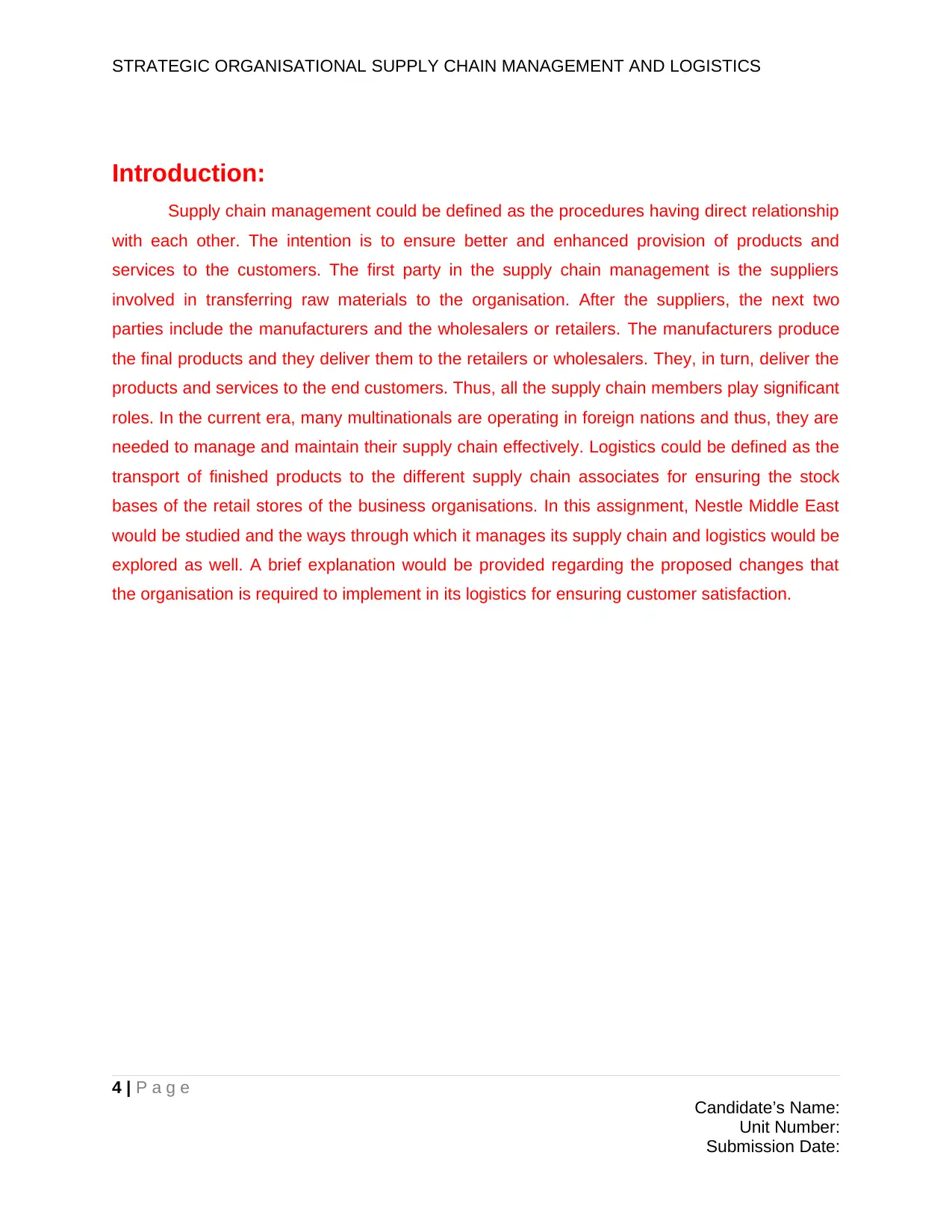
STRATEGIC ORGANISATIONAL SUPPLY CHAIN MANAGEMENT AND LOGISTICS
Introduction:
Supply chain management could be defined as the procedures having direct relationship
with each other. The intention is to ensure better and enhanced provision of products and
services to the customers. The first party in the supply chain management is the suppliers
involved in transferring raw materials to the organisation. After the suppliers, the next two
parties include the manufacturers and the wholesalers or retailers. The manufacturers produce
the final products and they deliver them to the retailers or wholesalers. They, in turn, deliver the
products and services to the end customers. Thus, all the supply chain members play significant
roles. In the current era, many multinationals are operating in foreign nations and thus, they are
needed to manage and maintain their supply chain effectively. Logistics could be defined as the
transport of finished products to the different supply chain associates for ensuring the stock
bases of the retail stores of the business organisations. In this assignment, Nestle Middle East
would be studied and the ways through which it manages its supply chain and logistics would be
explored as well. A brief explanation would be provided regarding the proposed changes that
the organisation is required to implement in its logistics for ensuring customer satisfaction.
4 | P a g e
Candidate’s Name:
Unit Number:
Submission Date:
Introduction:
Supply chain management could be defined as the procedures having direct relationship
with each other. The intention is to ensure better and enhanced provision of products and
services to the customers. The first party in the supply chain management is the suppliers
involved in transferring raw materials to the organisation. After the suppliers, the next two
parties include the manufacturers and the wholesalers or retailers. The manufacturers produce
the final products and they deliver them to the retailers or wholesalers. They, in turn, deliver the
products and services to the end customers. Thus, all the supply chain members play significant
roles. In the current era, many multinationals are operating in foreign nations and thus, they are
needed to manage and maintain their supply chain effectively. Logistics could be defined as the
transport of finished products to the different supply chain associates for ensuring the stock
bases of the retail stores of the business organisations. In this assignment, Nestle Middle East
would be studied and the ways through which it manages its supply chain and logistics would be
explored as well. A brief explanation would be provided regarding the proposed changes that
the organisation is required to implement in its logistics for ensuring customer satisfaction.
4 | P a g e
Candidate’s Name:
Unit Number:
Submission Date:
Paraphrase This Document
Need a fresh take? Get an instant paraphrase of this document with our AI Paraphraser
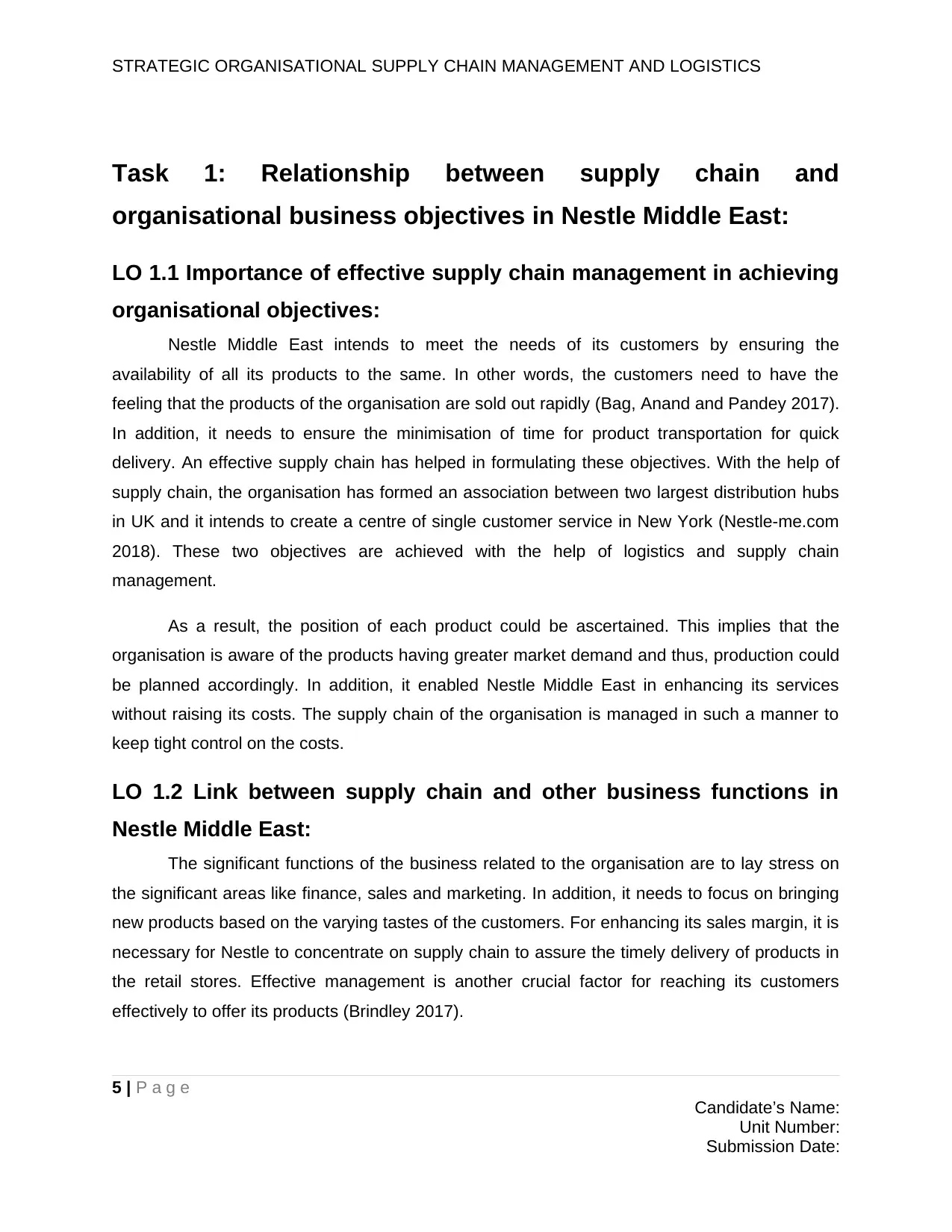
STRATEGIC ORGANISATIONAL SUPPLY CHAIN MANAGEMENT AND LOGISTICS
Task 1: Relationship between supply chain and
organisational business objectives in Nestle Middle East:
LO 1.1 Importance of effective supply chain management in achieving
organisational objectives:
Nestle Middle East intends to meet the needs of its customers by ensuring the
availability of all its products to the same. In other words, the customers need to have the
feeling that the products of the organisation are sold out rapidly (Bag, Anand and Pandey 2017).
In addition, it needs to ensure the minimisation of time for product transportation for quick
delivery. An effective supply chain has helped in formulating these objectives. With the help of
supply chain, the organisation has formed an association between two largest distribution hubs
in UK and it intends to create a centre of single customer service in New York (Nestle-me.com
2018). These two objectives are achieved with the help of logistics and supply chain
management.
As a result, the position of each product could be ascertained. This implies that the
organisation is aware of the products having greater market demand and thus, production could
be planned accordingly. In addition, it enabled Nestle Middle East in enhancing its services
without raising its costs. The supply chain of the organisation is managed in such a manner to
keep tight control on the costs.
LO 1.2 Link between supply chain and other business functions in
Nestle Middle East:
The significant functions of the business related to the organisation are to lay stress on
the significant areas like finance, sales and marketing. In addition, it needs to focus on bringing
new products based on the varying tastes of the customers. For enhancing its sales margin, it is
necessary for Nestle to concentrate on supply chain to assure the timely delivery of products in
the retail stores. Effective management is another crucial factor for reaching its customers
effectively to offer its products (Brindley 2017).
5 | P a g e
Candidate’s Name:
Unit Number:
Submission Date:
Task 1: Relationship between supply chain and
organisational business objectives in Nestle Middle East:
LO 1.1 Importance of effective supply chain management in achieving
organisational objectives:
Nestle Middle East intends to meet the needs of its customers by ensuring the
availability of all its products to the same. In other words, the customers need to have the
feeling that the products of the organisation are sold out rapidly (Bag, Anand and Pandey 2017).
In addition, it needs to ensure the minimisation of time for product transportation for quick
delivery. An effective supply chain has helped in formulating these objectives. With the help of
supply chain, the organisation has formed an association between two largest distribution hubs
in UK and it intends to create a centre of single customer service in New York (Nestle-me.com
2018). These two objectives are achieved with the help of logistics and supply chain
management.
As a result, the position of each product could be ascertained. This implies that the
organisation is aware of the products having greater market demand and thus, production could
be planned accordingly. In addition, it enabled Nestle Middle East in enhancing its services
without raising its costs. The supply chain of the organisation is managed in such a manner to
keep tight control on the costs.
LO 1.2 Link between supply chain and other business functions in
Nestle Middle East:
The significant functions of the business related to the organisation are to lay stress on
the significant areas like finance, sales and marketing. In addition, it needs to focus on bringing
new products based on the varying tastes of the customers. For enhancing its sales margin, it is
necessary for Nestle to concentrate on supply chain to assure the timely delivery of products in
the retail stores. Effective management is another crucial factor for reaching its customers
effectively to offer its products (Brindley 2017).
5 | P a g e
Candidate’s Name:
Unit Number:
Submission Date:
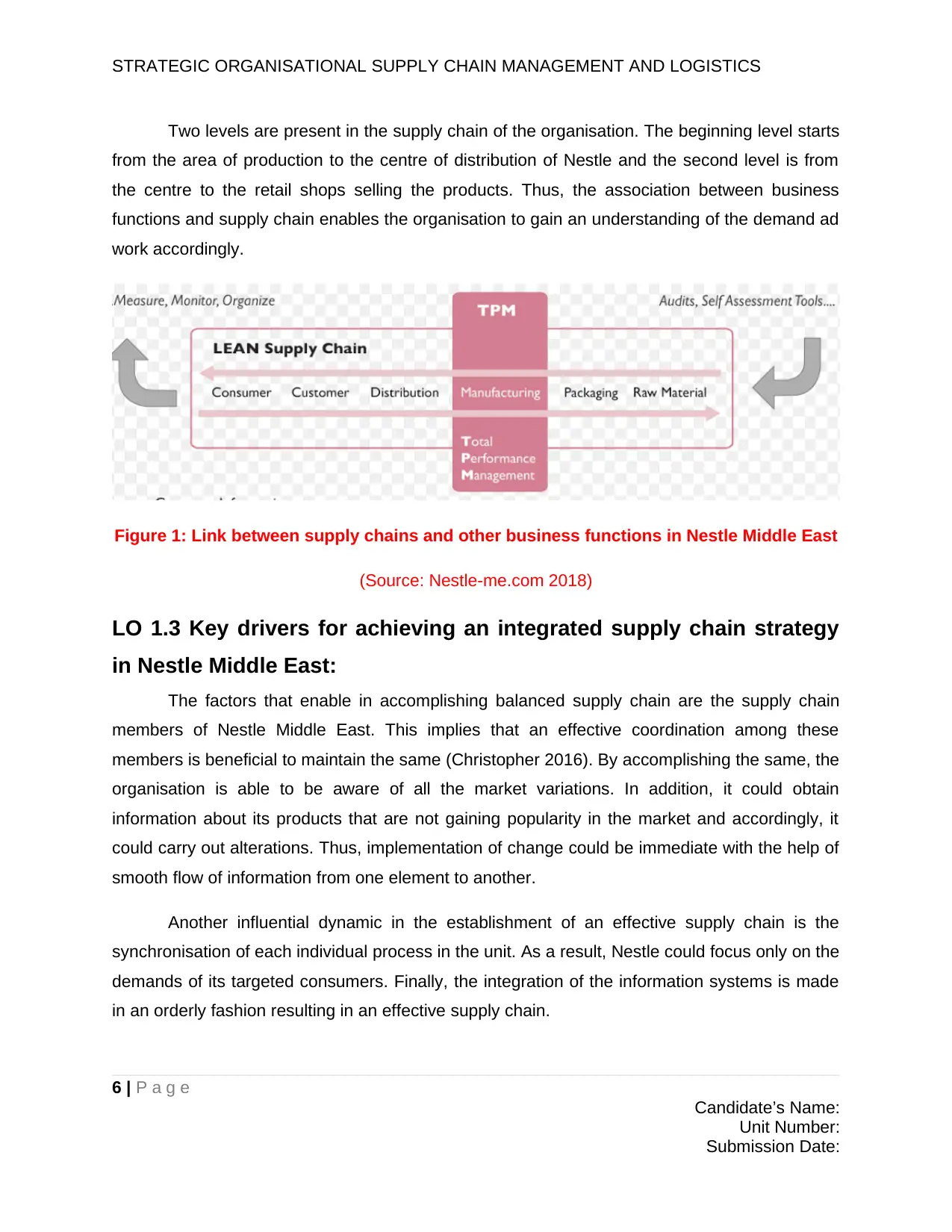
STRATEGIC ORGANISATIONAL SUPPLY CHAIN MANAGEMENT AND LOGISTICS
Two levels are present in the supply chain of the organisation. The beginning level starts
from the area of production to the centre of distribution of Nestle and the second level is from
the centre to the retail shops selling the products. Thus, the association between business
functions and supply chain enables the organisation to gain an understanding of the demand ad
work accordingly.
Figure 1: Link between supply chains and other business functions in Nestle Middle East
(Source: Nestle-me.com 2018)
LO 1.3 Key drivers for achieving an integrated supply chain strategy
in Nestle Middle East:
The factors that enable in accomplishing balanced supply chain are the supply chain
members of Nestle Middle East. This implies that an effective coordination among these
members is beneficial to maintain the same (Christopher 2016). By accomplishing the same, the
organisation is able to be aware of all the market variations. In addition, it could obtain
information about its products that are not gaining popularity in the market and accordingly, it
could carry out alterations. Thus, implementation of change could be immediate with the help of
smooth flow of information from one element to another.
Another influential dynamic in the establishment of an effective supply chain is the
synchronisation of each individual process in the unit. As a result, Nestle could focus only on the
demands of its targeted consumers. Finally, the integration of the information systems is made
in an orderly fashion resulting in an effective supply chain.
6 | P a g e
Candidate’s Name:
Unit Number:
Submission Date:
Two levels are present in the supply chain of the organisation. The beginning level starts
from the area of production to the centre of distribution of Nestle and the second level is from
the centre to the retail shops selling the products. Thus, the association between business
functions and supply chain enables the organisation to gain an understanding of the demand ad
work accordingly.
Figure 1: Link between supply chains and other business functions in Nestle Middle East
(Source: Nestle-me.com 2018)
LO 1.3 Key drivers for achieving an integrated supply chain strategy
in Nestle Middle East:
The factors that enable in accomplishing balanced supply chain are the supply chain
members of Nestle Middle East. This implies that an effective coordination among these
members is beneficial to maintain the same (Christopher 2016). By accomplishing the same, the
organisation is able to be aware of all the market variations. In addition, it could obtain
information about its products that are not gaining popularity in the market and accordingly, it
could carry out alterations. Thus, implementation of change could be immediate with the help of
smooth flow of information from one element to another.
Another influential dynamic in the establishment of an effective supply chain is the
synchronisation of each individual process in the unit. As a result, Nestle could focus only on the
demands of its targeted consumers. Finally, the integration of the information systems is made
in an orderly fashion resulting in an effective supply chain.
6 | P a g e
Candidate’s Name:
Unit Number:
Submission Date:
⊘ This is a preview!⊘
Do you want full access?
Subscribe today to unlock all pages.

Trusted by 1+ million students worldwide

STRATEGIC ORGANISATIONAL SUPPLY CHAIN MANAGEMENT AND LOGISTICS
Task 2: Use of information technology to optimise supplier
relationships in Nestle Middle East
LO 2.1 Effectiveness of strategies used by Nestle Middle East to
maintain supplier relationships:
In the current competitive landscape, every organisation aims to make profit to remain in
a win-win situation. The scenario is similar for Nestle as well, which is implementing changes so
that the profit margin could be maximised. This could be accomplished only, if effective and
positive relation is maintained with the suppliers and Nestle has been highly effective in
maintaining it. It has maintained effective terms with the constituents as well for raising its
overall sales in the Middle East (Dubey et al. 2017).
This positive relationship has helped Nestle in reaching its customers immediately and
when needed. Moreover, the wholesalers and the retailers help in providing useful information
to the organisation about the product demand based on the various demographic profiles of the
consumers (Grant, Wong and Trautrims 2017). As a result, Nestle has formulated ways of
targeting its customer group and the technique of production for meeting their needs. As the
intention of the organisation is to increase its customer base, it has accomplished the target due
to its effectiveness in maintaining healthy relationships with the suppliers in the Middle East
market.
LO 2.2 Use of information technology to create strategies to develop
relationship of Nestle Middle East with its suppliers:
The rapid and advanced information technology systems are one of the strongest
platforms in order to maintain the organisational processes effectively. Nestle Middle East uses
these systems for conducting its activities efficiently along with forming effective relationship
with the suppliers and other related associates of the supply chain. For assuring the same, the
organisation records its daily transactions, which are distributed to the members of the supply
chain afterwards. As a result, they have full knowledge of the overall business activities (Fernie
and Sparks 2014).
7 | P a g e
Candidate’s Name:
Unit Number:
Submission Date:
Task 2: Use of information technology to optimise supplier
relationships in Nestle Middle East
LO 2.1 Effectiveness of strategies used by Nestle Middle East to
maintain supplier relationships:
In the current competitive landscape, every organisation aims to make profit to remain in
a win-win situation. The scenario is similar for Nestle as well, which is implementing changes so
that the profit margin could be maximised. This could be accomplished only, if effective and
positive relation is maintained with the suppliers and Nestle has been highly effective in
maintaining it. It has maintained effective terms with the constituents as well for raising its
overall sales in the Middle East (Dubey et al. 2017).
This positive relationship has helped Nestle in reaching its customers immediately and
when needed. Moreover, the wholesalers and the retailers help in providing useful information
to the organisation about the product demand based on the various demographic profiles of the
consumers (Grant, Wong and Trautrims 2017). As a result, Nestle has formulated ways of
targeting its customer group and the technique of production for meeting their needs. As the
intention of the organisation is to increase its customer base, it has accomplished the target due
to its effectiveness in maintaining healthy relationships with the suppliers in the Middle East
market.
LO 2.2 Use of information technology to create strategies to develop
relationship of Nestle Middle East with its suppliers:
The rapid and advanced information technology systems are one of the strongest
platforms in order to maintain the organisational processes effectively. Nestle Middle East uses
these systems for conducting its activities efficiently along with forming effective relationship
with the suppliers and other related associates of the supply chain. For assuring the same, the
organisation records its daily transactions, which are distributed to the members of the supply
chain afterwards. As a result, they have full knowledge of the overall business activities (Fernie
and Sparks 2014).
7 | P a g e
Candidate’s Name:
Unit Number:
Submission Date:
Paraphrase This Document
Need a fresh take? Get an instant paraphrase of this document with our AI Paraphraser
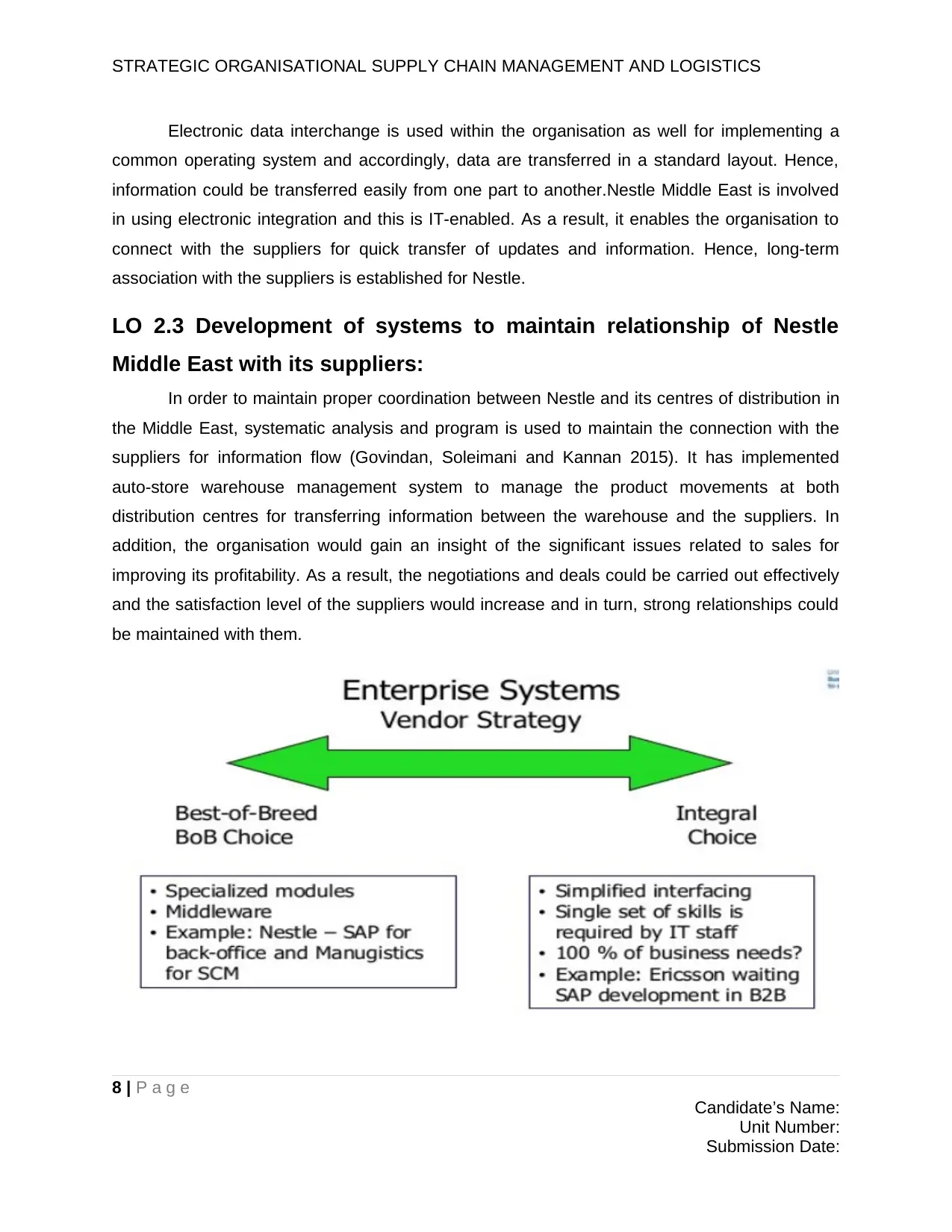
STRATEGIC ORGANISATIONAL SUPPLY CHAIN MANAGEMENT AND LOGISTICS
Electronic data interchange is used within the organisation as well for implementing a
common operating system and accordingly, data are transferred in a standard layout. Hence,
information could be transferred easily from one part to another.Nestle Middle East is involved
in using electronic integration and this is IT-enabled. As a result, it enables the organisation to
connect with the suppliers for quick transfer of updates and information. Hence, long-term
association with the suppliers is established for Nestle.
LO 2.3 Development of systems to maintain relationship of Nestle
Middle East with its suppliers:
In order to maintain proper coordination between Nestle and its centres of distribution in
the Middle East, systematic analysis and program is used to maintain the connection with the
suppliers for information flow (Govindan, Soleimani and Kannan 2015). It has implemented
auto-store warehouse management system to manage the product movements at both
distribution centres for transferring information between the warehouse and the suppliers. In
addition, the organisation would gain an insight of the significant issues related to sales for
improving its profitability. As a result, the negotiations and deals could be carried out effectively
and the satisfaction level of the suppliers would increase and in turn, strong relationships could
be maintained with them.
8 | P a g e
Candidate’s Name:
Unit Number:
Submission Date:
Electronic data interchange is used within the organisation as well for implementing a
common operating system and accordingly, data are transferred in a standard layout. Hence,
information could be transferred easily from one part to another.Nestle Middle East is involved
in using electronic integration and this is IT-enabled. As a result, it enables the organisation to
connect with the suppliers for quick transfer of updates and information. Hence, long-term
association with the suppliers is established for Nestle.
LO 2.3 Development of systems to maintain relationship of Nestle
Middle East with its suppliers:
In order to maintain proper coordination between Nestle and its centres of distribution in
the Middle East, systematic analysis and program is used to maintain the connection with the
suppliers for information flow (Govindan, Soleimani and Kannan 2015). It has implemented
auto-store warehouse management system to manage the product movements at both
distribution centres for transferring information between the warehouse and the suppliers. In
addition, the organisation would gain an insight of the significant issues related to sales for
improving its profitability. As a result, the negotiations and deals could be carried out effectively
and the satisfaction level of the suppliers would increase and in turn, strong relationships could
be maintained with them.
8 | P a g e
Candidate’s Name:
Unit Number:
Submission Date:

STRATEGIC ORGANISATIONAL SUPPLY CHAIN MANAGEMENT AND LOGISTICS
Figure 2: Information technology developed by Nestle Middle East to maintain supplier
relationships
(Source: Nestle-me.com 2018)
9 | P a g e
Candidate’s Name:
Unit Number:
Submission Date:
Figure 2: Information technology developed by Nestle Middle East to maintain supplier
relationships
(Source: Nestle-me.com 2018)
9 | P a g e
Candidate’s Name:
Unit Number:
Submission Date:
⊘ This is a preview!⊘
Do you want full access?
Subscribe today to unlock all pages.

Trusted by 1+ million students worldwide
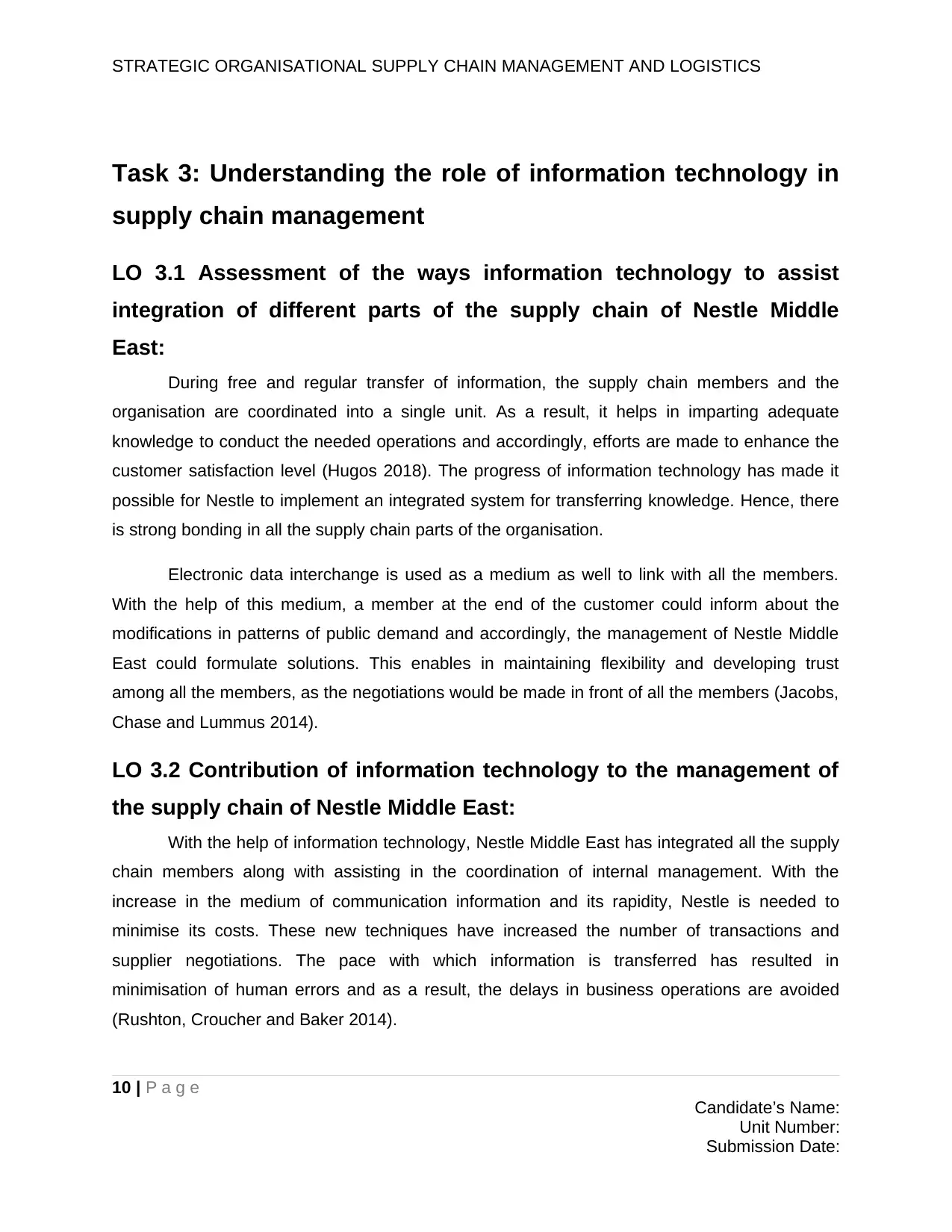
STRATEGIC ORGANISATIONAL SUPPLY CHAIN MANAGEMENT AND LOGISTICS
Task 3: Understanding the role of information technology in
supply chain management
LO 3.1 Assessment of the ways information technology to assist
integration of different parts of the supply chain of Nestle Middle
East:
During free and regular transfer of information, the supply chain members and the
organisation are coordinated into a single unit. As a result, it helps in imparting adequate
knowledge to conduct the needed operations and accordingly, efforts are made to enhance the
customer satisfaction level (Hugos 2018). The progress of information technology has made it
possible for Nestle to implement an integrated system for transferring knowledge. Hence, there
is strong bonding in all the supply chain parts of the organisation.
Electronic data interchange is used as a medium as well to link with all the members.
With the help of this medium, a member at the end of the customer could inform about the
modifications in patterns of public demand and accordingly, the management of Nestle Middle
East could formulate solutions. This enables in maintaining flexibility and developing trust
among all the members, as the negotiations would be made in front of all the members (Jacobs,
Chase and Lummus 2014).
LO 3.2 Contribution of information technology to the management of
the supply chain of Nestle Middle East:
With the help of information technology, Nestle Middle East has integrated all the supply
chain members along with assisting in the coordination of internal management. With the
increase in the medium of communication information and its rapidity, Nestle is needed to
minimise its costs. These new techniques have increased the number of transactions and
supplier negotiations. The pace with which information is transferred has resulted in
minimisation of human errors and as a result, the delays in business operations are avoided
(Rushton, Croucher and Baker 2014).
10 | P a g e
Candidate’s Name:
Unit Number:
Submission Date:
Task 3: Understanding the role of information technology in
supply chain management
LO 3.1 Assessment of the ways information technology to assist
integration of different parts of the supply chain of Nestle Middle
East:
During free and regular transfer of information, the supply chain members and the
organisation are coordinated into a single unit. As a result, it helps in imparting adequate
knowledge to conduct the needed operations and accordingly, efforts are made to enhance the
customer satisfaction level (Hugos 2018). The progress of information technology has made it
possible for Nestle to implement an integrated system for transferring knowledge. Hence, there
is strong bonding in all the supply chain parts of the organisation.
Electronic data interchange is used as a medium as well to link with all the members.
With the help of this medium, a member at the end of the customer could inform about the
modifications in patterns of public demand and accordingly, the management of Nestle Middle
East could formulate solutions. This enables in maintaining flexibility and developing trust
among all the members, as the negotiations would be made in front of all the members (Jacobs,
Chase and Lummus 2014).
LO 3.2 Contribution of information technology to the management of
the supply chain of Nestle Middle East:
With the help of information technology, Nestle Middle East has integrated all the supply
chain members along with assisting in the coordination of internal management. With the
increase in the medium of communication information and its rapidity, Nestle is needed to
minimise its costs. These new techniques have increased the number of transactions and
supplier negotiations. The pace with which information is transferred has resulted in
minimisation of human errors and as a result, the delays in business operations are avoided
(Rushton, Croucher and Baker 2014).
10 | P a g e
Candidate’s Name:
Unit Number:
Submission Date:
Paraphrase This Document
Need a fresh take? Get an instant paraphrase of this document with our AI Paraphraser
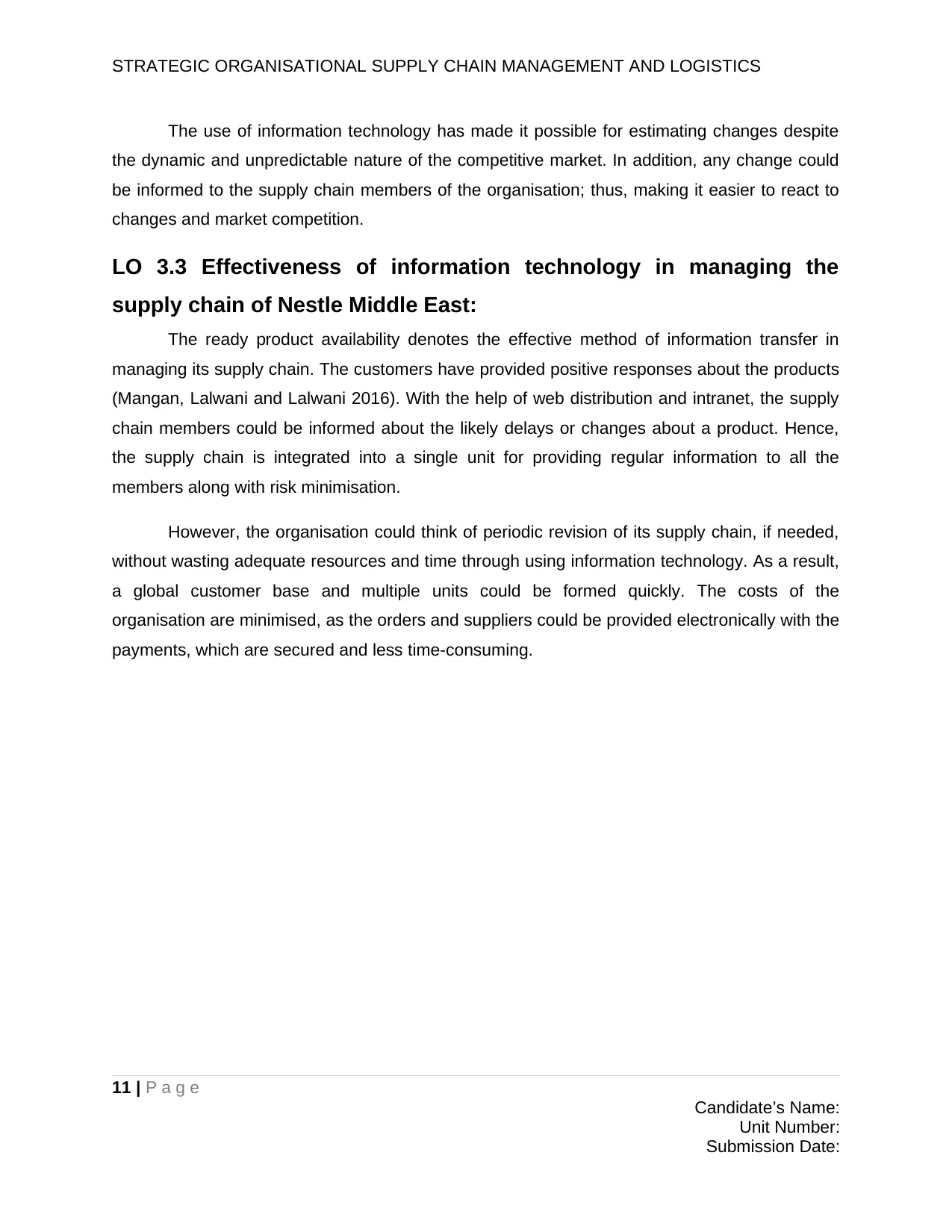
STRATEGIC ORGANISATIONAL SUPPLY CHAIN MANAGEMENT AND LOGISTICS
The use of information technology has made it possible for estimating changes despite
the dynamic and unpredictable nature of the competitive market. In addition, any change could
be informed to the supply chain members of the organisation; thus, making it easier to react to
changes and market competition.
LO 3.3 Effectiveness of information technology in managing the
supply chain of Nestle Middle East:
The ready product availability denotes the effective method of information transfer in
managing its supply chain. The customers have provided positive responses about the products
(Mangan, Lalwani and Lalwani 2016). With the help of web distribution and intranet, the supply
chain members could be informed about the likely delays or changes about a product. Hence,
the supply chain is integrated into a single unit for providing regular information to all the
members along with risk minimisation.
However, the organisation could think of periodic revision of its supply chain, if needed,
without wasting adequate resources and time through using information technology. As a result,
a global customer base and multiple units could be formed quickly. The costs of the
organisation are minimised, as the orders and suppliers could be provided electronically with the
payments, which are secured and less time-consuming.
11 | P a g e
Candidate’s Name:
Unit Number:
Submission Date:
The use of information technology has made it possible for estimating changes despite
the dynamic and unpredictable nature of the competitive market. In addition, any change could
be informed to the supply chain members of the organisation; thus, making it easier to react to
changes and market competition.
LO 3.3 Effectiveness of information technology in managing the
supply chain of Nestle Middle East:
The ready product availability denotes the effective method of information transfer in
managing its supply chain. The customers have provided positive responses about the products
(Mangan, Lalwani and Lalwani 2016). With the help of web distribution and intranet, the supply
chain members could be informed about the likely delays or changes about a product. Hence,
the supply chain is integrated into a single unit for providing regular information to all the
members along with risk minimisation.
However, the organisation could think of periodic revision of its supply chain, if needed,
without wasting adequate resources and time through using information technology. As a result,
a global customer base and multiple units could be formed quickly. The costs of the
organisation are minimised, as the orders and suppliers could be provided electronically with the
payments, which are secured and less time-consuming.
11 | P a g e
Candidate’s Name:
Unit Number:
Submission Date:
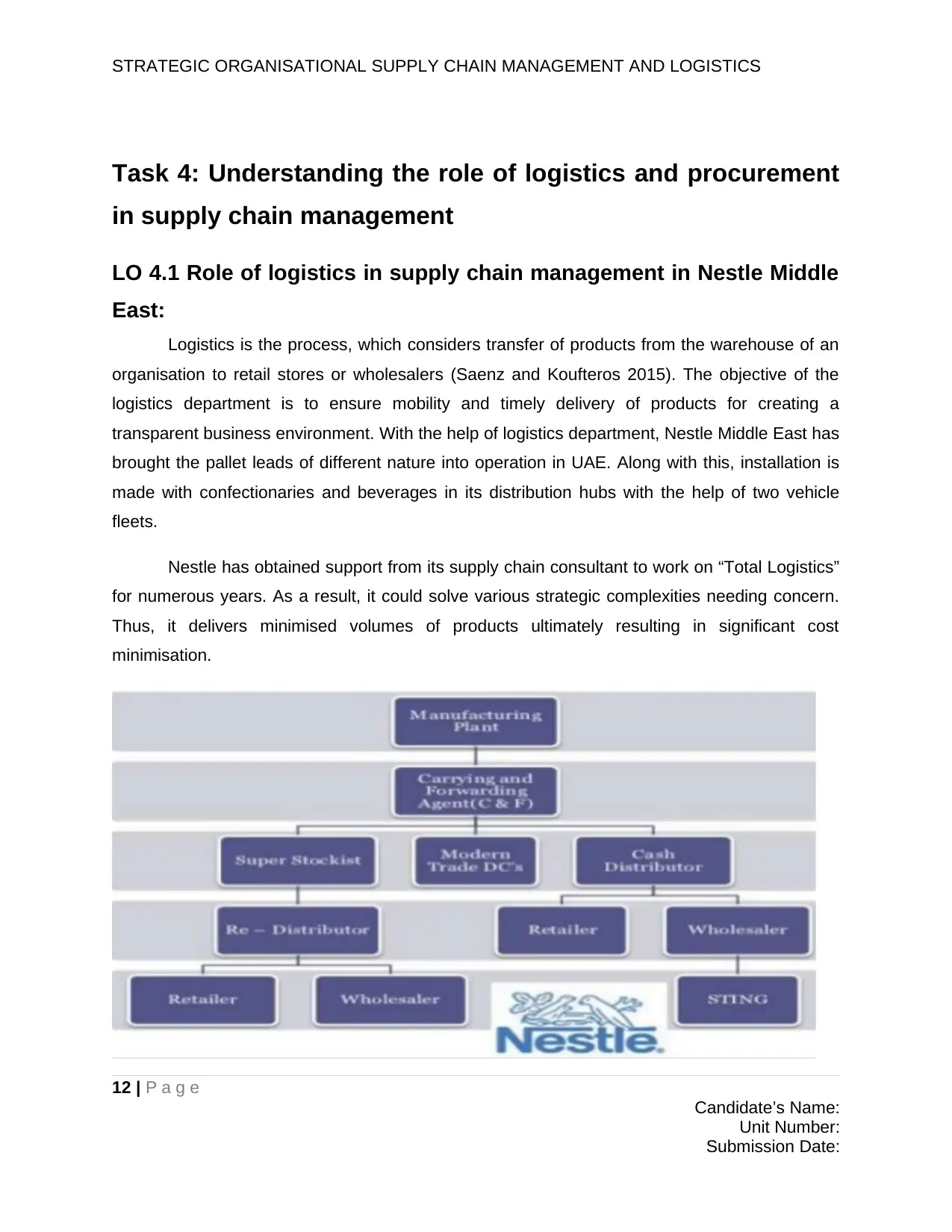
STRATEGIC ORGANISATIONAL SUPPLY CHAIN MANAGEMENT AND LOGISTICS
Task 4: Understanding the role of logistics and procurement
in supply chain management
LO 4.1 Role of logistics in supply chain management in Nestle Middle
East:
Logistics is the process, which considers transfer of products from the warehouse of an
organisation to retail stores or wholesalers (Saenz and Koufteros 2015). The objective of the
logistics department is to ensure mobility and timely delivery of products for creating a
transparent business environment. With the help of logistics department, Nestle Middle East has
brought the pallet leads of different nature into operation in UAE. Along with this, installation is
made with confectionaries and beverages in its distribution hubs with the help of two vehicle
fleets.
Nestle has obtained support from its supply chain consultant to work on “Total Logistics”
for numerous years. As a result, it could solve various strategic complexities needing concern.
Thus, it delivers minimised volumes of products ultimately resulting in significant cost
minimisation.
12 | P a g e
Candidate’s Name:
Unit Number:
Submission Date:
Task 4: Understanding the role of logistics and procurement
in supply chain management
LO 4.1 Role of logistics in supply chain management in Nestle Middle
East:
Logistics is the process, which considers transfer of products from the warehouse of an
organisation to retail stores or wholesalers (Saenz and Koufteros 2015). The objective of the
logistics department is to ensure mobility and timely delivery of products for creating a
transparent business environment. With the help of logistics department, Nestle Middle East has
brought the pallet leads of different nature into operation in UAE. Along with this, installation is
made with confectionaries and beverages in its distribution hubs with the help of two vehicle
fleets.
Nestle has obtained support from its supply chain consultant to work on “Total Logistics”
for numerous years. As a result, it could solve various strategic complexities needing concern.
Thus, it delivers minimised volumes of products ultimately resulting in significant cost
minimisation.
12 | P a g e
Candidate’s Name:
Unit Number:
Submission Date:
⊘ This is a preview!⊘
Do you want full access?
Subscribe today to unlock all pages.

Trusted by 1+ million students worldwide
1 out of 18
Related Documents
Your All-in-One AI-Powered Toolkit for Academic Success.
+13062052269
info@desklib.com
Available 24*7 on WhatsApp / Email
![[object Object]](/_next/static/media/star-bottom.7253800d.svg)
Unlock your academic potential
Copyright © 2020–2025 A2Z Services. All Rights Reserved. Developed and managed by ZUCOL.




